EXAMPLE 2Finding the Domain of a Function of Two Variables
Find the domain of each of the following functions. Then graph the domain.
- (a) z=f(x,y)=√16−x2−y2
- (b) z=f(x,y)=ln(y2−4x)
Solution (a) Since the expression under the radical must be nonnegative, the domain of f consists of all points in the plane for which 16−x2−y2≥0x2+y2≤16
The domain is all the points inside and on the circle x2+y2=16. The shaded portion of Figure 3 illustrates the domain.
(b) Since the logarithmic function is defined for only positive numbers, the domain of f is the set of points (x,y) for which y2−4x>0 or y2>4x. To graph the domain, we start with the parabola y2=4x, and use a dashed curve to indicate that the parabola is not part of the domain. The parabola y2=4x divides the plane into two sets of points: those for which y2<4x and those for which y2>4x. To find which points are in the domain, choose any point not on the parabola y2=4x and determine whether it satisfies the inequality. For example, the point (2,0) is not in the domain, since 02<(4)(2). The set of points for which y2>4x, the domain of f, is shaded in Figure 4.

